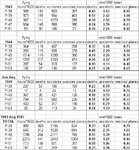P-39 manual shows 9.4gal oil with 15.8gal overload, P-63 manual shows 9.6gal/13.7gal overload. Pretty much the same.
Weight of the lubrication oil was not listed under weight of lubrication system, even the trapped oil was listed separately. Here we can see that 'Lubrication system' weights 56.2 lbs empty, same figure is repeated in the 'America's hundred thousand'. Same book states the 'Lubricating system' weight on the P-63 at 135-137 lbs.
Lets also recall that racing P-39s, like the Cobra II, featured an extra oil cooler, supposedly taken from a P-40. Despite still using a 1-stage engine, ie. without the hydraulic coupling adding to the cooling load. FWIW: link

